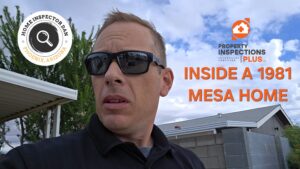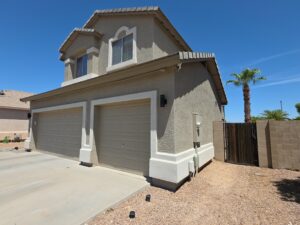As home inspectors, one of the most telling areas we evaluate during an inspection is the roof. When we see evidence of prior roof repairs – whether it’s patched shingles, mismatched materials, or flashing that’s been recently caulked – we pay close attention. While repairs are often a good sign that the homeowner addressed an issue, they can also raise red flags depending on how and why those repairs were made.

1. Repairs May Indicate a History of Leaks
One of the most immediate concerns with past roof repairs is what prompted them in the first place. Often, repairs suggest there was a leak or failure in the roofing system. The bigger question is whether the underlying cause was resolved or just covered up. For example, if only a few shingles were replaced but water damage remains in the decking below, the problem is far from over – and that could mean trouble for the new homeowner.
2. Quality of the Repair Matters
Quick patches done without addressing the root cause often fail over time. As inspectors, we look for signs of sloppy workmanship, like excessive roofing cement, reused flashings, or shingles installed without proper overlap. A properly executed roof repair should blend in and maintain the same level of protection as the rest of the roof. If it doesn’t, that’s a concern for longevity and future leaks.
3. Possible Warranty Voids or Insurance Issues
Many roof materials come with manufacturer warranties, but those warranties are often void if repairs were made with incompatible materials or by someone not certified. Similarly, an improperly repaired roof could be flagged by an insurance company, resulting in higher premiums or even denial of coverage. We bring this up so buyers know to ask questions and possibly consult a roofer before closing the deal.
4. Mismatched Materials Can Lead to Uneven Aging
It’s common to see mismatched shingles where a repair was done. Unfortunately, that patch may age differently than the rest of the roof, especially under Arizona’s intense sun. Different materials expand and contract at different rates, leading to premature failure in the repaired area and a risk for future leaks.
5. Hidden Structural Damage
A leaky roof often means water intrusion, and water has a way of traveling beyond what’s visible. A repaired section could hide rot, mold, or structural damage in the attic or ceiling. When we see signs of repair, we look closely at the attic insulation, trusses, and decking for moisture stains, warping, or microbial growth.
One of the most immediate concerns with past roof repairs is what prompted them in the first place. Often, repairs suggest there was a leak or failure in the roofing system. The bigger question is whether the underlying cause was resolved or just covered up. For example, if only a few shingles were replaced but water damage remains in the decking below, the problem is far from over and that could mean trouble for the new homeowner.
About the Author
 Hi, I’m Home Inspector Dan – owner of Property Inspections Plus and a Certified Master Inspector based in Gilbert, Arizona. With years of experience inspecting homes across the Valley, I specialize in helping buyers, sellers, and investors make informed decisions with confidence. Whether you’re purchasing your first home or evaluating an investment property, I provide thorough, honest, and easy-to-understand inspections — including sewer camera scans, mold inspections, infrared imaging, and termite inspections.
Hi, I’m Home Inspector Dan – owner of Property Inspections Plus and a Certified Master Inspector based in Gilbert, Arizona. With years of experience inspecting homes across the Valley, I specialize in helping buyers, sellers, and investors make informed decisions with confidence. Whether you’re purchasing your first home or evaluating an investment property, I provide thorough, honest, and easy-to-understand inspections — including sewer camera scans, mold inspections, infrared imaging, and termite inspections.
📍 Serving Gilbert, Chandler, Mesa, Tempe, and the greater Phoenix area
📞 Call or Text: (623) 399-0079
📧 Email: homeinspectordanaz@gmail.com
🌐 Website: www.propertyinspectionsplus.com

 Hi, I’m Home Inspector Dan — owner of Property Inspections Plus and a
Hi, I’m Home Inspector Dan — owner of Property Inspections Plus and a 



